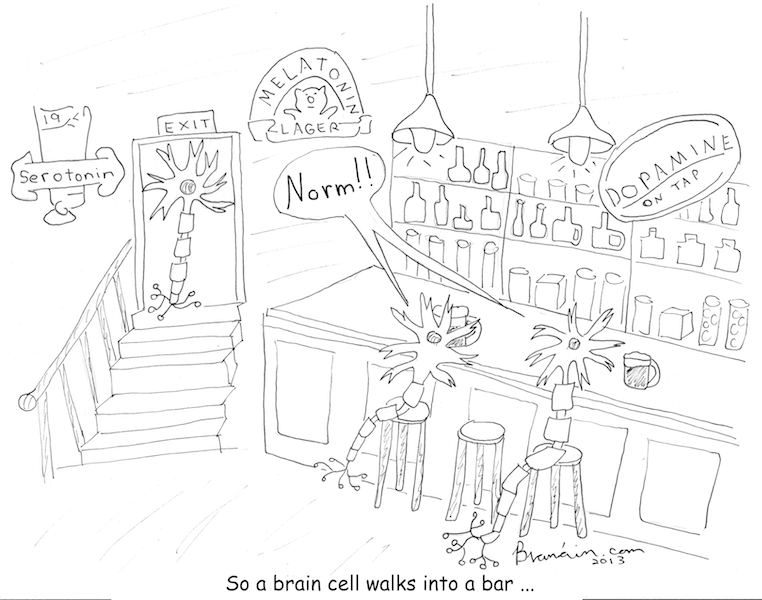Of all the alcoholic beverages, beer is the one that has the most acquired taste. Given enough time spent at the bar, you will eventually be able to kick back and enjoy a local IPA or a dark, almost chocolately stout. But in the beginning, having a beer is like drinking out of the urinal troughs found in old-school baseball stadiums.
Beer’s “distinctive” flavor (in the same way that wearing white socks with Birkenstocks is a “distinctive” look), however, might be a double-edged sword—holding newbies at bay while at the same time egging on experienced drinkers.
According to researchers at the Indiana University School of Medicine, the power of beer to keep people drinking may stem in part from its flavor, with that liquid sensory experience stimulating areas of the brain responsible for alcohol cravings.
Previous research has already shown that alcohol can cause the release of the neurotransmitter dopamine from part of the brain’s reward center—the ventral striatum. The new study, published in Neuropsychopharmacology, sought to tease apart the effect of alcohol from that of its flavor—separating the wheat from the chaff, or in this case, the barley.
“We believe this is the first experiment in humans to show that the taste of an alcoholic drink alone, without any intoxicating effect from the alcohol, can elicit this dopamine activity in the brain’s reward centers,” lead author David A. Kareken, Ph.D., said in a press release.
Drug-seeking behavior is thought to be driven by this increase in dopamine in the ventral striatum—known as the location where addiction starts in the brain. Understanding what controls the release of this neurotransmitter could give scientists more insight into how people develop alcoholism and why they relapse once sober.
Putting the Taste of Beer to the Test
Many men would eagerly jump at a chance to take part in a research study that involves drinking beer, but in this case the 49 men that signed up for this study were most likely disappointed.
In order to limit the intoxicating effect of alcohol on the brain, the researchers used a very small amount of beer—15 milliliters (about 3 teaspoons). This was sprayed onto the tongue through a tube inserted between the teeth (like a mini beer funnel). It may not have been the most pleasant way to drink a beer, but at least the participants were able to choose their preferred flavor.
As the volunteers enjoyed several tasty sprays of beer on their tongues over the course of 15 minutes, the researchers monitored the release of dopamine in their ventral striatum using a special imaging technique—positron emission tomography (PET).
They also measured the participants’ desire to drink before and during the brain scan—by asking them how many beers they were currently craving (try this at your next keg party … it’s a great icebreaker). In addition, the researchers ran the same tests using Gatorade (an equally strong-tasting beverage) instead of beer for comparison.
The Effect of Beer Flavor on the Brain
Once the 15-milliliter keg party was over, the researchers found that, compared to the taste of Gatorade, the taste of beer increased both the desire to drink and the amount of dopamine released in the ventral striatum.
In addition, the increase in dopamine was largest in men who had a first-degree relative with alcoholism. This may indicate that the dopamine response to the taste of beer is inherited, as well as a risk factor for developing alcoholism.
The researchers admit in their paper that they can’t be certain that the beer flavor caused the dopamine levels in the ventral striatum to increase. The study, however, still provides insight into how something as simple as the taste of beer can play a part in turning on the urge to drink.
Past studies have shown that, in addition to taste, sights and sounds (of a bar or alcohol) can spark alcohol cravings in some people. Understanding these triggers could help scientists design better treatment programs for people with alcohol dependency.
__________
Reference: Oberlin, B., Dzemidzic, M., Tran, S., Soeurt, C., Albrecht, D., Yoder, K., & Kareken, D. (2013). Beer Flavor Provokes Striatal Dopamine Release in Male Drinkers: Mediation by Family History of Alcoholism Neuropsychopharmacology DOI: 10.1038/npp.2013.91
Photo: Glasses of Beer, Some rights reserved by IntangibleArts
A Brain Cell Walks Into a Bar (cartoon) by Shawn Radcliffe, from Branáin – Ravenously Curious



